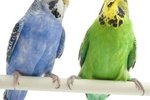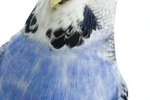
Parakeets and cockatiels are hardy birds, but both can get chilled in cool temperatures or when the weather changes. Both species exhibit the same behavior when they're cold. Pet birds such as parakeets and cockatiels are most comfortable with a median house temperature around 70 degrees.
The Puffball
Your bird may be cold when he fluffs up his feathers. He might look like a little downy ball. A bird puffs his feathers out to trap pockets of warm air next to his skin. Cockatiels and parakeets also puff their feathers when they're going to sleep -- so it can be hard to tell whether they're cold or napping. If your bird looks puffy during the daytime hours, ensure that he's not in a draft and that the temperature in the room is not too cool.
Other Signs
A chilly bird will frequently put his head down and tuck his beak into his chest. A cold bird will also shiver. Parakeets and cockatiels usually sleep on one foot with the other one curled up underneath them. If your bird's feathers are puffed up and it looks like he's sleeping on both feet, chances are he's cold. A cockatiel or parakeet who is comfortable will tuck his head into a wing to sleep. If he's huddling in a corner of the cage floor, he may be chilled.
A Bird's Metabolism

Parakeets and cockatiels maintain warmer body temperatures than humans do. Their normal body temperatures run between 102 and 112 degrees Fahrenheit -- they chill faster when the room is cold or the temperature drops. A pet bird has to work to maintain his body temperature. You'll notice your bird eats more when the weather turns chilly and through the winter months. That fact is why birds molt in the summer, when it's warmer.
Birdie, It's Cold Outside
Even if your house is a comfortable 75 degrees, your bird can get chilled. Pet birds love to have a view of the outdoors, but if you keep the cage near a window, consider moving it on a cold or windy day. Even if you can't feel the cold air coming in, your bird can. A chill in the fall can lead to an illness, so pay extra attention to the outdoor temperatures and be sure your bird's in cozy quarters.
References
- BirdChannel.com: Keep Your Pet Birds Warm & Safe This Winter
- Avian Web: How to Keep Your Pet Bird Happy
- BirdChannel.com: Cockatiels & Temperature Fluctuations
- The Complete Pet Bird Owner's Handbook; Gary A. Gallerstein
Photo Credits
-
BananaStock/BananaStock/Getty Images




